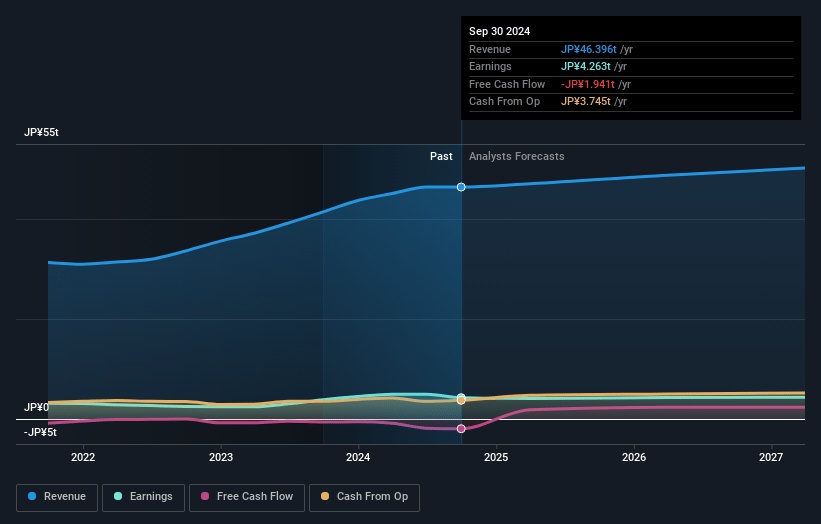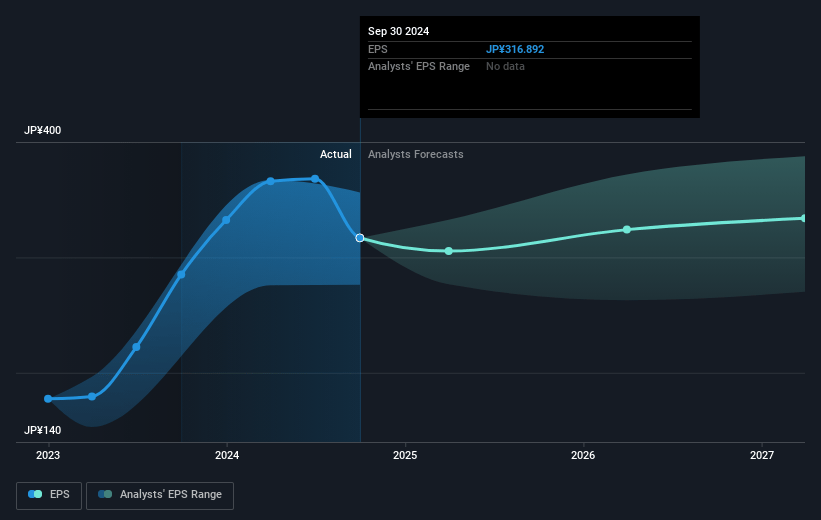Key Takeaways
- Efforts to recover production and reduce incentives aim to sustain and grow Toyota's profitability amid competitive markets.
- Investing in internal battery production and operational efficiency seeks to bolster revenue and margins in the electrified vehicle market.
- Production disruptions, currency fluctuations, and competitive pressures may challenge Toyota's profitability and growth, despite essential investments in human resources and operational foundations.
Catalysts
About Toyota Motor- Designs, manufactures, assembles, and sells passenger vehicles, minivans and commercial vehicles, and related parts and accessories in Japan, North America, Europe, Asia, Central and South America, Oceania, Africa, and the Middle East.
- Toyota aims to recover lost production volume in the second half of the fiscal year, intending to reach an annual global production pace of 10 million units. This is expected to positively impact revenue by increasing vehicle sales following earlier production halts.
- Efforts to reduce customer incentives while maintaining lean operations and establishing trusting customer relationships could result in improved profit margins. This strategy aims to sustain profitability despite competitive pressures in markets like North America.
- The expansion of value chain earnings, driven by increased maintenance packages and extended warranties, is expected to stabilize and enhance revenue streams. Such efforts to deepen customer relationships and offer additional services should support revenue growth beyond traditional vehicle sales.
- Toyota's investment in internal battery production, including various types of batteries for electric and hybrid vehicles, could bolster long-term revenue and margins. By optimizing battery production and technology, Toyota positions itself competitively in the growing electrified vehicle market.
- The strengthening of foundational operations, including shortening lead times and improving production flexibility, aims to enhance operational efficiency and reduce costs. These improvements are expected to positively impact net margins, resulting in stronger financial performance over time.
Toyota Motor Future Earnings and Revenue Growth
Assumptions
How have these above catalysts been quantified?- Analysts are assuming Toyota Motor's revenue will grow by 3.3% annually over the next 3 years.
- Analysts assume that profit margins will shrink from 10.9% today to 7.4% in 3 years time.
- Analysts expect earnings to reach ¥3820.7 billion (and earnings per share of ¥295.65) by about May 2028, down from ¥5098.1 billion today. However, there is a considerable amount of disagreement amongst the analysts with the most bullish expecting ¥4888.1 billion in earnings, and the most bearish expecting ¥2118.9 billion.
- In order for the above numbers to justify the analysts price target, the company would need to trade at a PE ratio of 13.4x on those 2028 earnings, up from 7.0x today. This future PE is greater than the current PE for the US Auto industry at 7.8x.
- Analysts expect the number of shares outstanding to decline by 2.81% per year for the next 3 years.
- To value all of this in today's terms, we will use a discount rate of 10.91%, as per the Simply Wall St company report.
Toyota Motor Future Earnings Per Share Growth
Risks
What could happen that would invalidate this narrative?- Production halts due to certification issues and the need to examine the manufacturing environment could negatively affect sales volume, leading to decreased revenue and potentially impacting earnings.
- Exchange rate fluctuations, particularly yen appreciation, have led to significant valuation losses in foreign currency denominated assets and may continue to affect net income.
- Competitive pressure in crucial markets such as China may lead to price wars, which could reduce profit margins and overall profitability.
- Declining sales volumes and unfavorable sales mix in regions like North America could affect operating income and limit growth opportunities.
- Increased investments in human resources and foundations, while essential, represent considerable costs that might strain net margins if not balanced by corresponding revenue growth and efficiency gains.
Valuation
How have all the factors above been brought together to estimate a fair value?- The analysts have a consensus price target of ¥3147.858 for Toyota Motor based on their expectations of its future earnings growth, profit margins and other risk factors. However, there is a degree of disagreement amongst analysts, with the most bullish reporting a price target of ¥3700.0, and the most bearish reporting a price target of just ¥2500.0.
- In order for you to agree with the analyst's consensus, you'd need to believe that by 2028, revenues will be ¥51567.8 billion, earnings will come to ¥3820.7 billion, and it would be trading on a PE ratio of 13.4x, assuming you use a discount rate of 10.9%.
- Given the current share price of ¥2729.0, the analyst price target of ¥3147.86 is 13.3% higher. Despite analysts expecting the underlying buisness to decline, they seem to believe it's more valuable than what the market thinks.
- We always encourage you to reach your own conclusions though. So sense check these analyst numbers against your own assumptions and expectations based on your understanding of the business and what you believe is probable.
How well do narratives help inform your perspective?
Disclaimer
AnalystConsensusTarget is a tool utilizing a Large Language Model (LLM) that ingests data on consensus price targets, forecasted revenue and earnings figures, as well as the transcripts of earnings calls to produce qualitative analysis. The narratives produced by AnalystConsensusTarget are general in nature and are based solely on analyst data and publicly-available material published by the respective companies. These scenarios are not indicative of the company's future performance and are exploratory in nature. Simply Wall St has no position in the company(s) mentioned. Simply Wall St may provide the securities issuer or related entities with website advertising services for a fee, on an arm's length basis. These relationships have no impact on the way we conduct our business, the content we host, or how our content is served to users. The price targets and estimates used are consensus data, and do not constitute a recommendation to buy or sell any stock, and they do not take account of your objectives, or your financial situation. Note that AnalystConsensusTarget's analysis may not factor in the latest price-sensitive company announcements or qualitative material.




